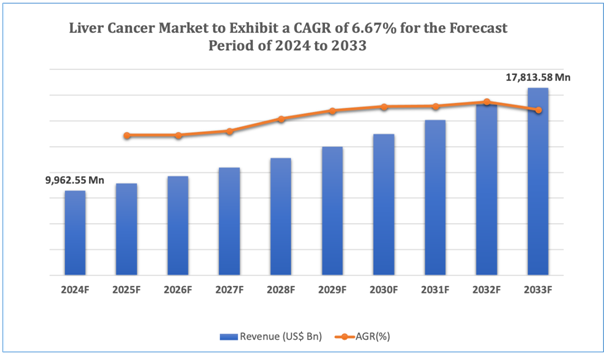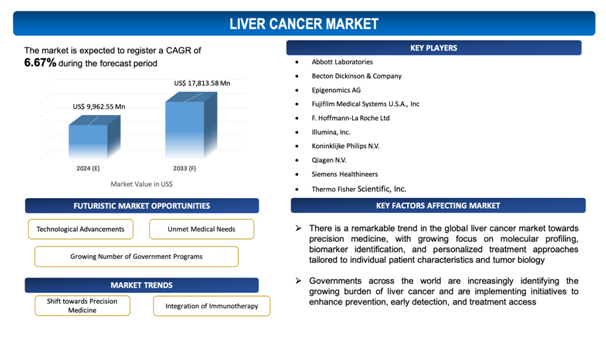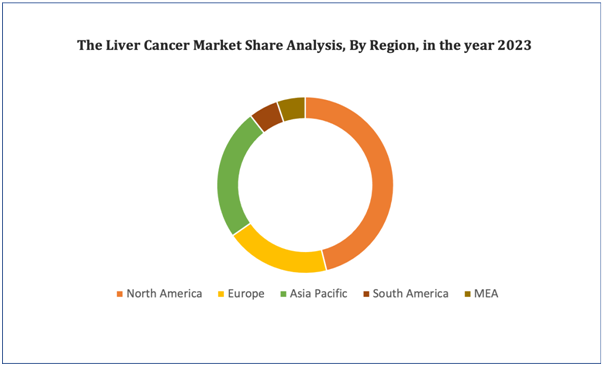Liver Cancer Market Overview
The global Liver Cancer market is estimated to be worth over USD 17,813.58Mn in 2033 and is expected to grow at CAGR of 6.67% during the forecast period (2024-2033). Liver cancer, mainly hepatocellular carcinoma (HCC), is a arduous global health challenge marked by the malignant proliferation of cells within the liver. It places as one of the most dangerous cancers across the world, oftentimesarising from chronic liver ailments such as alcoholic liver disease, hepatitis B and C infections, non-alcoholic fatty liver disease (NAFLD), and cirrhosis. The etiology of liver cancer is complicated, comprising a confluence of genetic, environmental, and lifestyle factors. Its aggressive nature and propensity for late-stage diagnosis contribute to its poor prognosis and increased mortality rates.
The global market for liver cancer surrounds a range of diagnostic, therapeutic, and supportive care interventions focused at combating this disease. Diagnostic tools scale from imaging techniques such as computed tomography (CT), ultrasound, magnetic resonance imaging (MRI), and biopsy procedures to molecular biomarkers that assist in early detection and staging of liver cancer. Early diagnosis is crucial for timely intervention and enhanced patient outcomes.
Therapeutically, the market provides a range of treatment modalities customized to the stage and severity of liver cancer. These comprise surgical interventions such as liver resection and transplantation, locoregional therapies like radiofrequency ablation (RFA), transarterial chemoembolization (TACE), and radioembolization, as well as systemic therapies including chemotherapy, targeted therapy, and immunotherapy. Emerging approaches such as combination therapies and novel drug delivery systems are also under investigation to improve treatment efficiency and curtail adverse effects.
Supportive care interventions hold an integral role in administering symptoms, allaying treatment-associatedadverse effects, and enhancing patients' quality of life. Palliative care services, nutritional support, pain management, and psychosocial interventions are crucial components of comprehensive care for individuals living with liver cancer.
While innovations in diagnostic technologies, treatment modalities, and supportive care strategies have enhanced outcomes for some patients, substantial challenges persist. These comprise the necessity for better early detection methods, access to affordable treatments, and the development of effective therapies for advanced-stage disease. Nonetheless, continuing research efforts and innovations in precision medicine offer hope for continued progress in addressing the global burden of liver cancer.
Figure 1. Liver Cancer: Market Size

Get more details on this report - Request Free Sample
Key Market Insights &Current Market Landscape:
The global liver cancer market stands as a dynamic panoramadefined by key market insights and major advancements. Growing incidence rates, fueled by factors such as chronic liver ailments and viral hepatitis infections, highlight the pressing need for effective interventions. The market is marked by a diverse range of diagnostic tools, therapeutic modalities, and supportive care alternatives. Significant developments comprise the emergence of targeted therapies and immunotherapies, providing new treatment avenues for patients with advanced liver cancer. In addition to that, advancements in diagnostic technologies, such as molecular biomarkers and imaging techniques, enable early detection and personalized treatment approaches. Locoregional therapies like radiofrequency ablation (RFA) and transarterial chemoembolization (TACE) persist to hold an essential role in disease management, specifically for patients with unresectable tumors. Along with that, the integration of multidisciplinary care models and palliative care services improves patient outcomes and quality of life. Despite these advancements, challenges such as late-stage diagnosis, limited treatment efficiency, and access barriers in underserved regions persist. Nonetheless, ongoing research and development efforts, along with innovations in precision medicine, hold commitment for enhancing patient outcomes and addressing the evolving landscape of the global liver cancer market.
Market Dynamics
Market Drivers
Rising Prevalence of Liver Cancer
Liver cancer is much more prevalent in countries in sub-Saharan Africa and Southeast Asia than in the US. In majority of these countries, it is the most prevalentkind of cancer. More than 800,000 people are diagnosed with this cancer every year throughout the world. Liver cancer is also a primary cause of cancer deaths across the world, accounting for more than 700,000 deaths each year.Factors contributing to this trend comprise the growing incidence of chronic liver diseases such as alcoholic liver disease, hepatitis B and C, non-alcoholic fatty liver disease (NAFLD), and cirrhosis. In addition to that, lifestyle factors such as unhealthy diet, obesity, and lack of physical activity further contribute to the burden of liver cancer. As the incidence of these predisposing conditions continues to surgeworldwide, the pool of individuals at risk for developing liver cancer expands, fueling the demand for diagnostic, therapeutic, and supportive care interventions. This greater prevalence highlights the pressing need for effective treatments and early detection methods to minimize the impact of liver cancer on public health. Pharmaceutical companies, healthcare providers, and researchers are thus incentivized to invest in research and development efforts aimed at developing innovative therapies, diagnostic tools, and treatment strategies to address the soaring burden of liver cancer. Furthermore, rising awareness of liver cancer among patients and healthcare professionals contributes to improved screening practices and early intervention, further encouraging market growth and innovation in the global liver cancer market.
Market Restraints
With regard to numerous advantages of Liver Cancer, the market faces several challenges due to the unique characteristics and requirements associated with them. Some of the key market challenges include:
- Limited Treatment Options: Despite advancements, treatment alternatives for liver cancer, particularly in advanced stages, remain limited, resultingin challenges in achieving favourable outcomes and addressing patient needs effectively.
- High Treatment Costs: The high costs associated with the liver cancer treatments, comprising chemotherapy, surgery, targeted therapy, and immunotherapy, pose a significant financial burden on patients and healthcare systems, limiting access to care and impeding market growth.
Market Opportunities
Growing Number of Government Programs
Governments across the world are increasingly identifying the growing burden of liver cancer and are implementing initiatives to enhance prevention, early detection, and treatment access. For instance, in August 2022, the National Cancer Institute (NCI) sponsored researchers from Baylor College of Medicine, Texas with USD 5.5 million in a 5-year grant. These programs oftentimescomprise public health campaigns to raise awareness about liver cancer risk factors, encourage screening among high-risk populations, and support vaccination against hepatitis viruses. In addition to that, governments may allocate funds for research grants, clinical trials, and infrastructure development to support advancements in liver cancer diagnostics and therapeutics. By fostering collaboration between public health agencies, healthcare providers, industry stakeholders, and patient advocacy groups, these government programs create a conducive environment for innovation and market growth in the liver cancer space. Along with that, reimbursement policies and healthcare reforms introduced through government initiatives can improves patient access to life-saving treatments and improve healthcare delivery for individuals affected by liver cancer. Overall, the growing support from government programs not only addresses unmet medical needs but also stimulates investment, advancements, and market expansion in the global liver cancer market.
Market Trends
- Shift towards Precision Medicine: There is a remarkable trend in the global liver cancer market towards precision medicine, with growingfocus on molecular profiling, biomarker identification, and personalized treatment approaches tailored to individual patient characteristics and tumor biology.

Get more details on this report - Request Free Sample
Liver Cancer Market: Key Segments
By Test Type
- Laboratory Test
- Biomarkers
- Oncofetal and Glycoprotein Antigens
- Enzymes and Isoenzymes
- Growth Factors and Receptors
- Molecular Markers
- Pathological Biomarkers
- Blood Tests
- Biomarkers
- Imaging
- Endoscopy
- Biopsy
- Others
By End Use
- Hospitals & Diagnostic Laboratories
- Academic & Research Institutes
- Pharmaceutical & CRO Laboratories
By Key Geographical Regions
- North America
- Europe
- Asia-Pacific
- Middle East and Africa
- South America
Liver Cancer Market: Regional Analysis
North America dominated the liver cancer diagnostics market and is projected to generate the highest revenue during the forecast period. The well-established healthcare settings, extensive reimbursement framework, rising implementation of novel diagnostics, and adoption of healthcare insurance policies among the population contribute to the dominance of this region in the market. Additionally, due to the increasing incidence of various tumor cases, supportive government organizations like CDC, NIH, and IARC, among others in this region, also boost the research & development of new testing & screening methods. Furthermore, the presence of market players in North America allows for easy and early access to novel solutions worldwide.
Figure 4. Liver Cancer Market: Distribution by Region

Get more details on this report - Request Free Sample
Leading Liver Cancer Developers
Industry Trends and Global Forecasts, 2023-2035 report features an extensive study of the current market landscape, market size and future opportunities associated with the Liver Cancermarket, during the given forecast period. Further, the market report highlights the efforts of several stakeholders engaged in this rapidly emerging segment of the biopharmaceutical industry. Key takeaways of the Liver Cancermarket are briefly discussed below.
The report includes the list of players operating in the global Liver Cancermarket. Some of the key players include:
- Abbott Laboratories
- Becton Dickinson & Company
- Epigenomics AG
- Fujifilm Medical Systems U.S.A., Inc
- F. Hoffmann-La Roche Ltd
- Illumina, Inc.
- Koninklijke Philips N.V.
- Qiagen N.V.
- Siemens Healthineers
- Thermo Fisher Scientific, Inc.
Recent Developments in the Liver Cancer Market
Several recent developments have taken place in the field of Liver Cancer, some of which have been outlined below. These developments, even if they took place post the release of our market report, substantiate the overall market trends that we’ve outlined in our analysis chronologically.
- On November, 2023, for the first time in India, Terumo has introduced an advanced therapy called Balloon-TACE (B-TACE) for the management of liver cancer. With Occlusafe, Terumo’s B-TACE device, patients benefit from more precise and targeted delivery of chemotherapy drug to the tumour.
Scope of the Report
The market report presents an in-depth analysis of the various firms / organizations that are engaged in this market, across different segments, as defined in the below table:
|
Key Report Attributes |
Details |
|
Base Year |
2023 |
|
Forecast Period |
2024-2033 |
|
CAGR (2024-2033) |
6.67% |
|
Test Type |
|
|
End Use |
|
|
Key Geographical Regions |
|
|
Key Companies Profiled |
|
